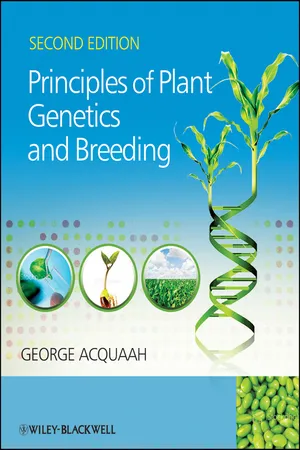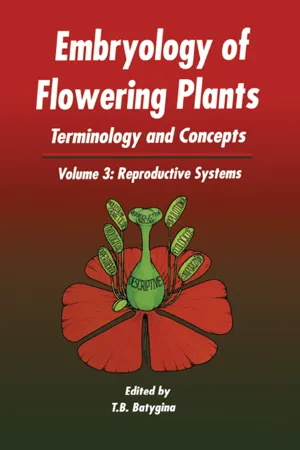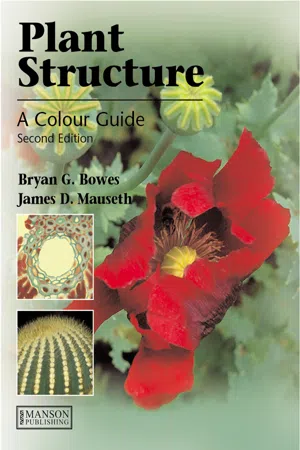Biological Sciences
Plants Reproduction
Plant reproduction involves the process by which plants produce offspring. It can occur through sexual reproduction, involving the fusion of male and female gametes, or asexual reproduction, where new plants are generated from vegetative parts. Sexual reproduction in plants often involves the production of flowers, pollination, and the development of seeds and fruits.
Written by Perlego with AI-assistance
Related key terms
8 Key excerpts on "Plants Reproduction"
- eBook - ePub
- Charles Adams, Mike Early, Jane Brook, Katherine Bamford(Authors)
- 2015(Publication Date)
- Routledge(Publisher)
4CHAPTERLevel 3Plant reproduction
Figure 4.1 Bees and other pollinating insects are attracted to large, colourful fl owers. The Iris shown has blue fl owers, a colour attractive to bumble bees, and tepals which can support the bee’s weight with nectar guides directing the bees towards nectaries at their baseThis chapter includes the following topics:• Inflorescence types• Pollination syndromes• Cross- and self-pollination mechanisms• The relevance of cross-and self-pollination to horticulture• Fertilization• Seed structure – endospermic and non-endospermic seeds• Seed dormancy• Seed quality – testing and treatments• Seed provenance and conservation• Fruit development, structure and classification• Asexual reproduction and vegetative propagationPrinciples of Horticulture. 978-0-415-85909-7 © C.R. Adams, M.P. Early, J.E. Brook and K.M. Bamford. Published by Taylor & Francis. All rights reserved. Figure 4.2 Inflorescences which are designed to maximize pollen dispersal and capture: (a) in a Betula (birch) left, female catkins; right, male catkins; (b) in grassesReproduction is the process by which new individuals are formed and hence the species is perpetuated. In plants this can be asexual, by means of a range of vegetative structures or it can be sexual resulting in seeds. Sexual reproduction has two key advantages for the plant. It gives rise to variation in a plant's offspring, enabling it to withstand environmental pressures and it also provides the means by which plants can colonize new areas, through dispersal of seeds, often enclosed within a fruit. Although plants produced from seed are genetically variable and will not be uniform in their growth and other characteristics such as size, flower colour etc., this variation can be controlled by skilled plant breeders (see F1 hybrids p. 47 - eBook - ePub
- Rene Fester Kratz(Author)
- 2011(Publication Date)
- For Dummies(Publisher)
Part III Making More Plants: Plant Reproduction and GeneticsIn this part . . .If you want to talk about sex, you’re in the right part. All joking aside, plants can reproduce asexually by making new individuals that are exact copies of the original plant, and sexually by producing sperm and eggs. When plants reproduce, they pass copies of their genetic information to the next generation. The patterns of inheritance in plants can be predicted by using the laws of genetics first discovered by Gregor Mendel’s study of peas. In this part, I outline the basic rules of genetics and talk about the basics of plant reproduction.Passage contains an image
Chapter 11 Greening the Earth: Plant Reproduction In this ChapterComparing asexual and sexual reproductionMaking more cells with mitosisProducing haploid cells with meiosisGetting into plant life cyclesPReproducing: More Than One Way to Do Itlants are very versatile in that they can reproduce both asexually and sexually. During asexual reproduction, plants use mitosis to make offspring that are genetically identical to themselves. During sexual reproduction, plants use meiosis to produce haploid cells that eventually lead to the formation of gametes. Plant life cycles are complex because they contain two separate alternating generations – one haploid, and one diploid. In this chapter, I explore the pros and cons of different types of reproduction and present the details on exactly how plants do it.Asexual reproductionPlants are extremely successful organisms in part due to their reproductive flexibility. People can reproduce only by getting together with a mate, but plants have more options. While some plants do reproduce sexually, many plants produce offspring all by themselves by growing underground stems or bulbs that generate new shoots.If you’ve ever put a plant cutting in a glass of water to get it to root, then you’ve seen first hand that some plants can reproduce themselves without any help from another plant. New plants that grow from pieces of old plants are called - eBook - ePub
- George Acquaah(Author)
- 2012(Publication Date)
- Wiley-Blackwell(Publisher)
gametes . Gametes are products of meiosis and, consequently, seeds are genetically variable. Asexual or vegetative reproduction mode entails the use of any vegetative part of the plant for propagation. Some plants produce modified parts, such as creeping stems (stolons or rhizomes), bulbs or corms, which are used for their propagation. Asexual reproduction is also applied to the condition whereby seed is produced without fusion of gametes (called apomixis). It should be pointed out that some plants could be reproduced by either the sexual or asexual mode. However, for either ease of propagation or for product quality, one mode of reproduction, often the vegetative mode, is preferred. Such is the case in flowering species such as potato (propagated by tubers or stem cuttings) and sugarcane (propagated by stem cuttings).5.4 Sexual Reproduction
Sexual reproduction increases genetic diversity through the involvement of meiosis. Flowering plants dominate the terrestrial species. Flowering plants may reproduce sexually or asexually.5.4.1 Sexual Lifecycle of a Plant (Alternation of Generation)
The normal sexual lifecycle of a flowering plant may be simply described as consisting of events from first establishment to death (from seed to seed in seed-bearing species). A flowering plant goes through two basic growth phases – vegetative and reproductive , the former preceding the latter. In the vegetative phase, the plant produces vegetative growth only (stem, branches, leaves, etc., as applicable). In the reproductive phase, flowers are produced. In some species, exposure to a certain environmental factor (e.g., temperature, photoperiod) is required to switch from the vegetative to the reproductive phase. The duration between phases varies among species and can be manipulated by modifying the growing environment.For sexual reproduction to occur, two processes must occur in sexually reproducing species. The first process, meiosis, reduces the chromosome number of the diploid (2n ) cell to the haploid (n ) number. The second process, fertilization, unites the nuclei of two gametes, each with the haploid number of chromosomes, to form a diploid. In most plants, these processes divide the lifecycle of the plant into two distinct phases or generations, between which the plant alternates (called alternation of generation ) (Figure 5.1 ). The first phase or generation, called the gametophyte generation , begins with a haploid spore produced by meiosis. Cells derived from the gametophyte by mitosis are haploid. The multicellular gametophyte produces gametes by mitosis. The sexual reproductive process unites the gametes to produce a zygote that begins the diploid sporophyte generation - eBook - ePub
Embryology of Flowering Plants: Terminology and Concepts, Vol. 3
Reproductive Systems
- T B Batygina(Author)
- 2019(Publication Date)
- CRC Press(Publisher)
PART ONE–PLANT REPRODUCTIONPassage contains an image OVERVIEW Reproductive Biology
Reproductive processes have exceptional significance not only in regular renewal of plant cover, but also in restoration of the foundation of our existence — the diverse world of plants, which has been disturbed in consequence of the continuous rise in anthropogenic pressures. Hence, repeated attempts to draw the attention of scientists to the problems of reproduction, and especially seed propagation, are well justified.Levina (1981) undertook one such attempt in her book Reproductive Biology of Seed Plants. Problem Review (Fig. 1 ). While highly appreciating this work and realizing its importance for the development of our knowledge on reproductive processes in plants and approaches to their investigation, we find that certain aspects of concepts that entered our scientific practice in the context of reproductive biology should now be critically evaluated. This needs to be done because the reproductive biology in Levina’s work is represented as a new synthetic approach to the study of reproductive cycles. The question that could and should be raised nowadays is whether the notion “reproductive biology” reflects a new scientific problem and consequently a new scientific approach, or whether it is only a more modern designation of a particular area of research in botany.According to Levina, plant reproductive biology developed gradually from the direction of plant reproduction and propagation studies, which was earlier referred to as “biology of propagation”. She emphasized that reproductive biology is first of all distinguished by a larger volume of investigations, connected with various levels of study of propagation processes. The biology of propagation has been studied just at the organism level and has taken into consideration hereditary morphophysiological peculiarities of an organism, whereas reproductive biology is studied at the species level and reflects the dependence of propagation on the ecological situation. - eBook - ePub
- Peter Scott(Author)
- 2013(Publication Date)
- Wiley-Interscience(Publisher)
Longevity . Plants may, in many instances, be long-suffering and long-lasting, but if the great extinctions of the past teach us anything, it is that nothing lasts forever. No matter how old an individual plant is, one day conditions will change to make survival impossible. Plants need some means of surviving such adverse conditions, which may be local or temporary, and reproduction can offer a solution to this. Clonal plants may move away from the point of origin of the mother plant and therefore widen the spread of the plant, thereby escaping a particular stress. In addition, seeds offer even greater opportunities to disperse genetic material well away from the parent plant and also provide a structure that can remain dormant over prolonged periods. This permits a plant to survive temporary changes in conditions. Clones or seeds also produce new individuals which are free from fungal infections or damage present in the parent plant.3. Genetic variation . Finally, reproduction offers opportunities for genetic variation, which is essential in a changing habitat. Asexual reproduction offers little opportunity for genetic variation but the potential from sexual reproduction is immense.In this chapter we will look in greater detail at how plants reproduce and the merits and limitations of the different methods.Asexual reproduction
Many plant species use asexual reproduction as a means of propagation. Asexual reproduction has several advantages and disadvantages (Figure 9.1 ). This form of reproduction produces individuals that are genetically identical and does not support much scope for phenotypic variation. This can lead to plants being vulnerable to changes in the habitat. In addition, offspring are generated close to the parent plant, so parent and offspring often have to compete for nutrients and light. However, asexually produced plants usually attain adulthood in advance of seedlings of the same parent and hence rapidly out-compete neighbouring plants reliant on seeds. Under many conditions, asexual reproduction is more successful than sexual reproduction for plants and a large number of species use this as their sole means of reproduction.Figure 9.1 Asexual reproduction in plants. Plants possess a range of different means of asexual reproduction. (A) Apomixis: using this method, the flowers spontaneously produce seeds without the need for any fertilization. The actual source of the embryo can come from the egg cell or the cells surrounding it. (B) A hyacinth bulb (Hyacinthus hybrid); bulbs frequently produce bulbils (small offset bulbs) at the base of the bulb. (C) A gladiolus corm (Gladiolus hybrid); corms frequently produce small offset corms at the base of the stem. (D) Strawberry plant (Fraxinus hybrid), forming runners, modified stems that form new plants. (E) Black poplar (Populus nigra - eBook - ePub
- George Acquaah(Author)
- 2020(Publication Date)
- Wiley-Blackwell(Publisher)
allogamous (pollen comes from a different flower). There are finer differences in these types. For example, there may be differences between the time of pollen shed and stigma receptivity.- Self‐fertilization versus cross‐fertilization
Just because a flower is successfully pollinated does not necessarily mean fertilization would occur. The mechanism of self‐incompatibility causes some species to reject pollen from their own flowers, thereby promoting outcrossing.- Sexuality versus asexuality
Sexually reproducing species are capable of providing seed through sexual means. Asexuality manifests in one of two ways – vegetative reproduction (in which no seed is produced), or agamospermy (in which seed is produced).5.3 Types of reproduction
Plants are generally classified into two groups based on mode of reproduction: sexually reproducing or asexually reproducing. Sexually reproducing plants produce seed as the primary propagule. Seed is produced after sexual union (fertilization) involving the fusion of sex cells or gametes. Gametes are products of meiosis and, consequently, seeds are genetically variable. Asexual or vegetative reproduction mode entails the use of any vegetative part of the plant for propagation. Some plants produce modified parts such as creeping stems (stolons or rhizomes), bulbs, or corms, which are used for their propagation. Asexual reproduction is also applied to the condition whereby seed is produced without fusion of gametes (called apomixis). It should be pointed out that some plants could be reproduced by either the sexual or asexual mode. However, for either ease of propagation or for product quality, one mode of reproduction, often the vegetative mode, is preferred. Such is the case in flowering species such as potato (propagated by tubers or stem cuttings) and the sugarcane (propagated by stem cuttings).5.4 Sexual reproduction
Sexual reproduction increases genetic diversity through the involvement of meiosis. Flowering plants dominate the terrestrial species. Whereas flowers are required, flowering plants may reproduce sexually or asexually. - eBook - ePub
Science Knowledge for Primary Teachers
Understanding the Science in the QCA Scheme
- Linda Gillard(Author)
- 2013(Publication Date)
- David Fulton Publishers(Publisher)
Chapter 5 .In considering sexual reproduction in plants, I shall refer only to flowering plants. A very simple classification of living organisms has two main groups, plants and animals. In the same way that there are lots of different types of animals, so there are lots of different types of plants. Children tend to use ‘plant’ as though it is synonymous with just one of these groups, the flowering plants, in the same way that they use animal as synonymous with mammal. Flowering plants are all plants that produce flowers, whether these flowers are large and showy, such as buttercup, daisy and rose, or small and inconspicuous as in cereals and other grasses or willow catkins. Some plants, conifers, produce seeds but do not have flowers. Other common non-flowering plants are ferns and mosses, but these do not produce seeds.The basis of sexual reproduction is the same in all organisms. There are two different sexes, each of which produces special sex cells (gametes) that need to be brought together to fuse (fertilisation) in order to form the beginning of the next generation (the zygote).Figure 3.2 The principle of sexual reproductionDifferent organisms produce these sex cells in different structures: ovaries and testes in mammals, anthers and ovaries in flowering plants. Organisms produce a variety of different sex cells – from the swimming gametes of moss plants, sperm and eggs (ova) in humans to pollen and ovules in flowering plants. The mechanisms used to bring the gametes together vary, as does the way in which the zygote develops.In flowering plants, the flower is the reproductive structure and, although some flowering plants produce separate male and female flowers, most contain both the male and female reproductive organs. This basic structure is not always clear in cultivated plants because these have been bred to be attractive. If you want to see the main parts of a flower, you need to select suitable flowers and, to show children, ideally ones that are as large as possible. - eBook - ePub
- Bryan G. Bowes, James D. Mauseth(Authors)
- 2008(Publication Date)
- CRC Press(Publisher)
CHAPTER 8Plant Reproduction
ASEXUAL (VEGETATIVE) REPRODUCTION
Vegetative reproduction in nature
In numerous land plants, ranging from bryophytes to many vascular taxa, vegetative reproduction occurs naturally as an adjunct to, or sometimes a replacement for, the sexual process (468 –470 ). Considerable areas of land may become colonized by clonal individuals and in northwest America Populus tremuloides (quaking aspen) rarely reproduces by seed but extensive forests have arisen from adventitious root buds (471 ).Many plants show modifications related to both perennation and vegetative reproduction. Rhizomes, which are long-lived stems with numerous adventitious roots and often bearing scale leaves, grow more or less horizontally beneath the soil surface; their axillary or terminal buds give rise to aerial shoots (469 , 470 , 472). In Pteridium aquilinum (bracken) the rhizome internodes may reach 1 m or more in length and lie deep beneath the soil surface. Rhizomes are generally thick and fleshy and in the palm Nypa fruticans can reach up to 50 cm in diameter; however, some may be only a few millimetres thick, as in various grasses.Rosette plants often develop thin runners or stolons, with long internodes (473 ). These stems creep along the soil surface, rooting at the nodes where new plantlets eventually develop due to the decay of the intervening tissues. Stem tubers are typically underground swollen shoots arising from axillary stolons on the aerial plant as in Solanum tuberosum (338 , 474), now domesticated as the edible potato, but with several hundred wild relatives still distributed from the southwestern USA to the Andes in South America.A perennating taproot typically incorporates some hypocotyl tissue, with dormant buds, where it was originally attached to the aerial shoot as in Daucus carota (carrot, 475 ). Both bulbs and corms represent vertically growing subterranean shoots. However, a bulb has a very condensed stem bearing many leaves packed with food reserves (476 ), whereas the greatly swollen stem of a corm stores the food for the growth of the next season’s aerial shoot (477 ). In numerous taxa, the aerial stems, inflorescences, and leaves bear various vegetative bulbils and small tubers (27A
Learn about this page
Index pages curate the most relevant extracts from our library of academic textbooks. They’ve been created using an in-house natural language model (NLM), each adding context and meaning to key research topics.







